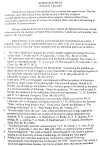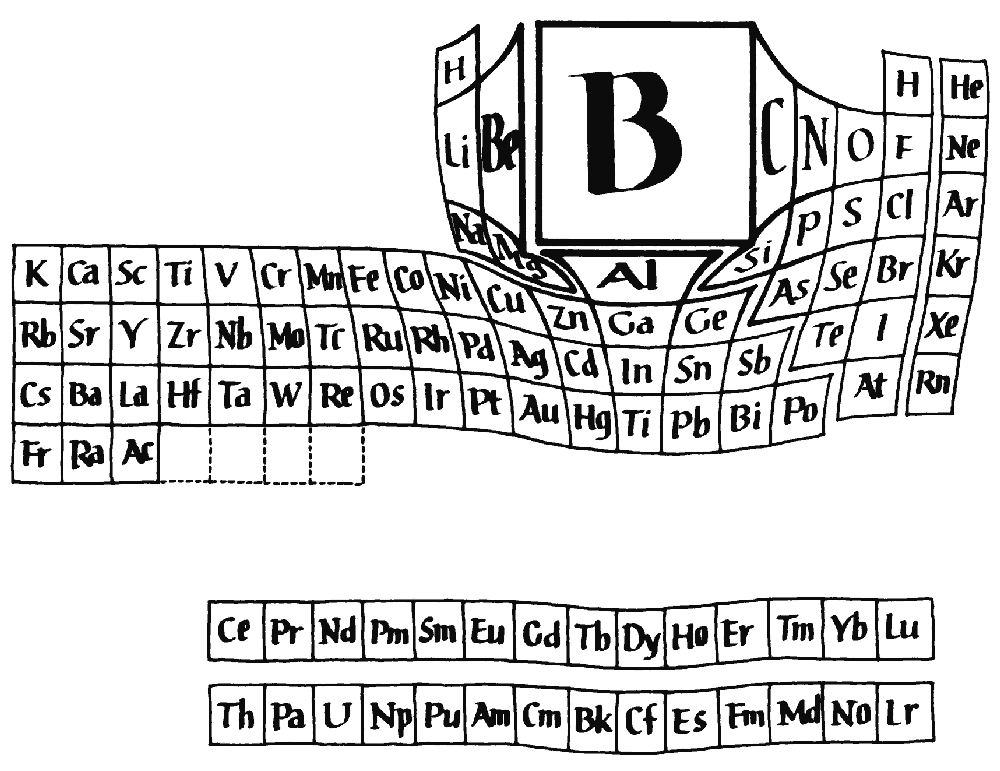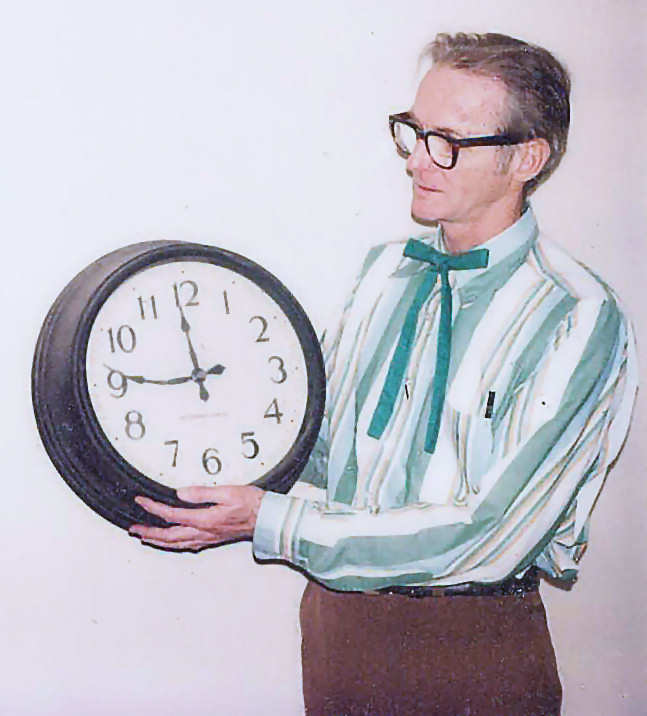 Humor in Science.
Bill's list 1-25 (unpublished, except of course here on the
Internet and in pieces in the publications cited).
Humor in Science.
Bill's list 1-25 (unpublished, except of course here on the
Internet and in pieces in the publications cited).William Lipscomb Home Page
Biographical Information and Publications
Science Humor
Nobel Prize Scrapbook
Scientific Aggression as a Way of Life
Early-Years Family Stories
Portraits
Remembrances
Cllected by James Lipscomb and Margaret Lipscomb.
1. Direct from Bill
"Humor, in my opinion, is an
essential part of presentation in Science." - W.N. Lipscomb, Jr.,
Humor in Science (below)
Bill's
list of humor in his scientific publications.
Some of Bill's favorites:
2. “We admittedly made this
observation with the benefit of hindsight. This science is
known as retrospectroscopy.” E. A. Laws, R. M. Stevens, and
W. N. Lipscomb, J. Am. Chem. Soc. 94, 4473 (1972).
4. “In the early 1970’s we frequently superimposed a diffraction
pattern of aluminum powder on single crystal X-ray photographs
[for calibration]. The mounted sample, labeled as Al Powder,
was thought by one member of my research group to be labeled by
the name of a previous member of the group. Hence the
quotation,” “We also wish to thank Al Powder for assistance in the
calibration of the unit cell parameters.” C. H. Schwalbe,
and W. N. Lipscomb, Inorganic Chem. 10, 160 (1971).
6. “We also thank Alice, the cow, who while nevertheless still
living, supplied the pancreatic juice from which our crystals of
the enzyme carboxypeptidase were obtained.” W. N. Lipscomb,
J. A. Hartsuck, G. N. Reeke, Jr., F. A. Quiocho, P. H. Bethge, M.
L. Ludwig, T. A. Steitz, H. Muirhead, and J. C. Coppola,
Brookhaven Symp. Biol. 21, 85 (1968).
16. The footnote, “M. V. King and W. N. Lipscomb, to be
unpublished,” W. N. Lipscomb, J. Chem. Phys. 22, 986 (1954).
18. “We wish to thank the Office of Navel Research….” R. Hegstrom
and W. N. Lipscomb, J. Chem. Phys. 46, 4539 (1967). The
error, Navel, as in belly-button, was made by the journal when
typing the galley proofs. Bill let it be published, but, as
a gentleman, had it corrected for the reprints.
 Humor in Science.
Bill's list 1-25 (unpublished, except of course here on the
Internet and in pieces in the publications cited).
Humor in Science.
Bill's list 1-25 (unpublished, except of course here on the
Internet and in pieces in the publications cited).
1.2. A New Enzyme
A spoof paper in manuscript (#25 in Bill's Humor in Science list above) published as "Ein neues Enzym" in Nachrichten aus Chemie und Technik, v19, #7, p122 (1971). Humor in the categories of enzyme humor, crystallography humor, crystal structure humor, and electron density map humor.
A New Enzyme spoof paper, draft in English. (Publication in German)
1.3 Bill's Ph.D. Dissertation
In the Propositions section, page 71 in the text (PDF page 83 of 86).
11 (a) "Research and study at the Institute has been unnecessarily hampered by the present policy of not heating the buildings on weekends."
11 (b) "Manure should not be used as a fertilizer on ground adjacent to the Campus Coffee Shop."
Bill's Ph. D. Dissertation (PDF). See the Propositions section, page 71 in the text (PDF page 83 of 86). Lipscomb, William N. (1946) Part 1, Electron diffraction investigations of vanadium tetrachloride, dimethylketene dimer, tetrachloroethylene, and trichloroethylene; Part 2, The crystal structure of methylammonium chloride. Dissertation, California Institute of Technology.
1.4. Periodic Table

Bill's rendition of the Periodic Table of the elements
We see that boron has one more electron than beryllium and one less electron than carbon. Bill sought to learn more about the nature of the chemical bond through calculation. But the computing time grows dramatically and beyond the possible very quickly with the number of electrons, placing most carbon compounds out of reach in the 1960s. The fewer electrons the better for calculations, but the chemistry of beryllium and lithium is correspondingly less complex. That leaves boron.
1.5. Dow Board
Bill served in a scientist position on the Dow Chemical Company Board of Directors from 1982 to 1990. He served on the Environment, Health and Safety Committee and the Public Interest Committee of the Dow Board of Directors. By 1984 Bill concluded that the group photos looked dull and added a Hawaiian shirt, which his daughter, Dorothy, bought for him.
Bill also brought his regular shirt, back row third from the left.
1.6. Ig Nobel
Bill was a frequent and enthusiastic participant in the Ig Nobel Prizes Ceremonies and other zaniness sponsored by Marc Abrahams of the Annals of Improbable Research.
Special Issue Remembering Professor Lipscomb, pages 6-15. Download a free low-res PDF or buy a high-res PDF from: Annals of Improbable Research (AIR), Volume 17, Issue 43, July/Aug. 2011.
Professor Lipscomb demonstrates how to tie a string tie video from Improbable TV, Improbable Research Collection #123, 2009
Professor Lipscomb Makes Home-Brew Tea, Annals of Improbable Research (AIR), Volume 7, Issue 6, Nov./Dec 2001. (Permission to host this reprint has been generously granted by Marc Abrahams, editor of the AIR.)
Professor Lipscomb Makes a Cup of Tea, Annals of Improbable Research (AIR), Volume 7, Issue 2, Mar./Apr. 2001. (Permission to host this reprint has been generously granted by Marc Abrahams, editor of the AIR.)
Professor Lipscomb Goes Shopping, Annals of Improbable Research (AIR), Volume 6, Issue 3, May/June 2000. (Permission to host this reprint has been generously granted by Marc Abrahams, editor of the AIR.)
Nobel Thoughts: William Lipscomb, Annals of Improbable Research (AIR), Volume 5, Issue 4, July/Aug. 1999. (Permission to host this reprint has been generously granted by Marc Abrahams, editor of the AIR.)
_Ig Nobel Prize Ceremonies videos from 2001 to the present include Bill.
2. About Bill
2.1. Songs
Herbert Beall, songwriter and Bill's Ph.D. student, sings his borderline-satirical view of life in Bill's lab at Harvard in the 1960s. The satirical slant to the songs is much clearer in the way they are sung, playing the MP3 files instead if reading the lyrics.
The Clock
The hall clock outside of Bill's office in the Wolcott Gibbs Memorial Laboratory was five minutes slow. Bill was tired of being five minutes late to lectures, so he called Harvard Buildings and Grounds for someone to fix it. They replied that no, they would not, because it was impossible. The reason, they explained, was that because all clocks were ticked forward once each minute from a central control, if they sent five extra ticks to make his clock correct, then all the other clocks on campus would be five minutes ahead.
No argument from Bill. He avoids personal confrontations, preferring technical replies. He got a ladder and found that by flipping the clock upside down at the half-minute mark he could advance it an extra tick every minute. But that solution was unsatisfying, so he took off the minute hand and went to the vise.
The line "...bent and banged and swore," lampoons the fact that Bill was well known never, under any circumstances, to swear.

The Clock, 1976
The Clock ---> Play MP3 (2:33)
Free music download with generous permission from Herb Beall's widow, Barbara A. Beall (see copyright section below).
There's a clock that hangs high upon the wall and it calls its mind its own,
For it gives wrong time to both great and small and its will is made of stone.
It's a model of life to weaker folk, inspirational is to me.
Though the mightiest man it may provoke, it will never humbled be.
Oh, sing aloud and n'er forget the strong proud clock that won’t be set.
Now there came a man with an active mind, who prefers the world his way.
Should he something less than perfection find, he will set it right that day.
He eyed the clock with a visage cold and he stripped it from the wall,
For to set it right he then made bold, ‘neath his will that clock must fall.
Oh, sing aloud and n'er forget the strong proud clock that won’t be set.
Then the fiercest battle did take place as he bent and banged and swore,
But at last sad tears wet the clock’s proud face, and it could resist no more.
Now it’s mutilated quiet and sad. It is far to tired to fight.
T’was a fine proud clock that once we had, but now our clock is right
Oh, sing aloud with sad regret the strong proud clock has now been set.
The Commander
Herb Beall composed this song for I think the going-away party for Bill's sabbatical leave in 1966 to Cambridge England to learn large-molecule crystallography of proteins. There is a reference to Bill "working every night," which he did and which may have made the graduate students feel obliged do the same.
The Commander ---> Play MP3 (2:59)
Free music download with generous permission from Herb Beall's widow, Barbara A. Beall (see copyright section below).
When with eye both sad and tearful off the great Commander goes.
Cynics say some men are cheerful now instead of work they’ll doze.
Cynics say there’ll be much Hell-ing, when the great Commander leaves.
But the truth I’m truly telling, every Trooper truly grieves.
But the truth I’m truly telling, every Trooper truly grieves.
Who will guide us, who will lead us, who will set our clock aright,
Never chide us or impede us, help us on to greater height.
When the Leader says adieu, those not sighing are the few.
Those not sighing, those not sighing, those not sighing are the few.
When with eye both sad and tearful the Commander goes away,
Cynics say that they are fearful he’ll not work a single day.
Cynics say that he’ll be drinking in the pub by flickering light,
But the truth I’m truly thinking he’ll be working every night.
But the truth I’m truly thinking he’ll be working every night.
Who will guide us, who will lead us, who will set our clock aright,
Never chide us or impede us, help us on to greater height.
When the Leader says adieu, those not sighing are the few.
Those not sighing, those not sighing, those not sighing are the few.
Oh for Days ---> Play MP3 (3:05)
Free music download with generous permission from Herb Beall's widow, Barbara A. Beall (see copyright section below).
In a golden sea of glory dwells an isle with silver tower.
There stands Gibbs Lab famed in story where we spent our heaped on hour.
Though the king was just and kindly to his goodness we were dim,
And we criticized him blindly, un-appreciating him.
Now with life we have to grips come. Now it’s life, which we must face.
Oh, for days with Colonel Lipscomb and his easy going pace.
Oh, for days with Colonel Lipscomb and his easy going pace.
Sometimes he would give suggestion in his unassuming way,
And his wisdom we would question though we rue our words today.
He would wander off dejected to his parapet above,
Wondering how one so neglected can win students lasting love.
From our mouths unkindly quips come. Yes, we have abused him so.
Oh, for days with Colonel Lipscomb and his nature calm and slow.
Oh, for days with Colonel Lipscomb and his nature calm and slow.
Now that island seems so distant. ‘Tis a wonder to behold,
How it can be so resistant to a world that’s harsh and cold.
Quotas deadlines they’re not given. All exists for joy and light.
No one ever sternly driven, no one ever works at night.
To that island hopeful ships come that they may imbibe the cheer.
Oh, for days with Colonel Lipscomb and the parties and the beer.
Oh, for days with Colonel Lipscomb and the parties and the beer.
Dr. Herbert Beall became a professor
of chemistry at Worcester Polytechnic Institute and died in
2003. List of his students
and publications. His ACS
Obituary.
Permission to make these songs
available for free download and distribution was generously
granted by Herbert Beall's widow, Barbara A. Beall.
Kaesz, H. D., Bau, R., Beall, H. A.,
and Lipscomb, W. N., "Rearrangements in the Icosahedral
Carboranes," J. Am. Chem. Soc.
89, 4218-4220 (1967).
Beall, H. A. and Lipscomb, W. N.,
"Molecular and Crystal Structure of m-B10Br2H8C2H2,"
Inorg. Chem. 6, 874-879 (1967).
Beall, H. A. and Lipscomb, W. N., "A
New Method for the Preparation of B6H10," Inorg. Chem. 3, 1783 (1964).
Bill was enlisted to help Hypho-Man in
the boron
entry in the Periodic
Table of Comic Books by John P. Selegue and F. James Holler,
University of Kentucky. As no real comic book mentioning
boron could be found, they made up a fragment of one, complete
with a story.
"Hypho" signifies a polyhedral cage
that is missing some vertices, a little like the upper half of the
green borane structure below. This may be the most obscure
and nerdy superhero name ever.
Image credits
Bill's Periodic Table of the elements: From Bil's collection, drawn for him by his second wife Jean C. Evans as work under a government contract and therefore in the public domain, reprinted on this website with permission from William Lipscomb.
Dow Board, 2 photos: From Bill's photo collection, reprinted on this website with permission from William Lipscomb.
The Clock, 1976: Photo by James Lipscomb.
(Permission to distribute Herb Beall MP3 songs is discussed below.)
An early, abbreviated version of this web page is published under the terms of the Creative Commons copyright below in the book, The Selected Papers of William N Lipscomb Jr.: A Legacy in Structure-Function Relationships.
-- Nov. 2009, last updated June 2017,Home page https://wlipscomb.tripod.com/
Work on this page (text and images except as noted immediately below) is by http://wlipscomb.tripod.com and is licensed under a Creative Commons Attribution 3.0 Unported License. You are free to copy, distribute, transmit, and modify the work for both commercial and non-commercial uses. You must attribute the work to website http://wlipscomb.tripod.com
Exception: Herb Beall's Songs are copypright by Herbert Beall and freely available under the Creative Commons License immediately above with generous permission of his widow, Barbara A. Beall.